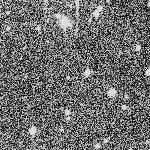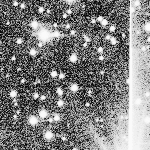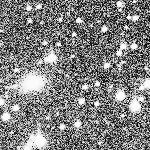Images of Real FMOs
Below are images of FMOs found by FMO reviewers. Later pages of the tutorial will show pictures of image flaws, stellar bodies and spurious FMOs that you will need to identify as "uninteresting" and therefore unworthy of reporting to SPACEWATCH® for follow-up.
MPC NAME: 2003 WU21
DATE FOUND: 2003 Nov 21
FOUND BY: Stu Megan
CHARACTERISTICS:
The FMO looks like a "star smeared along the CCD surface." The edge blends with the background and the signal level is low (compare with the sharp edge, high signal of a cosmic ray shown later in tutorial.) This is termed "fuzzy". All real stellar bodies appear fuzzy due to the light passing through our atmosphere.
Note the uniform width of the trail (compare with that of a galaxy or tumbling satellite). The length of this trail is typical.
MPC NAME: 2004 SW130
DATE DISCOVERED: 2004 Jan 19
DISCOVERED BY: Stu Megan
CHARACTERISTICS:
Again, image does not have stark edges and is close to the level of the background. Like the first example, the trail is of fairly uniform width.
This is the first FMO discovered by one of our FMO reviewers and designated by the MPC 2004 BV18.
MPC NAME: 2000 EV70
DATE RECOVERED: 2004 Mar 01
RECOVERED BY: Peter Lake
CHARACTERISTICS:
This was deliberate recovery for this object so that the time delay between images as drastically shortened. That is the only reason the object appears in all three passes.
This PHA, which has not seen since 2000 April 23, was recovered by one of our FMO reviewers and MPC added to MPEC 2004-E11.
Now that you know how to identify an FMO, we need to review images that appear to be reportable FMOs but which are not.




